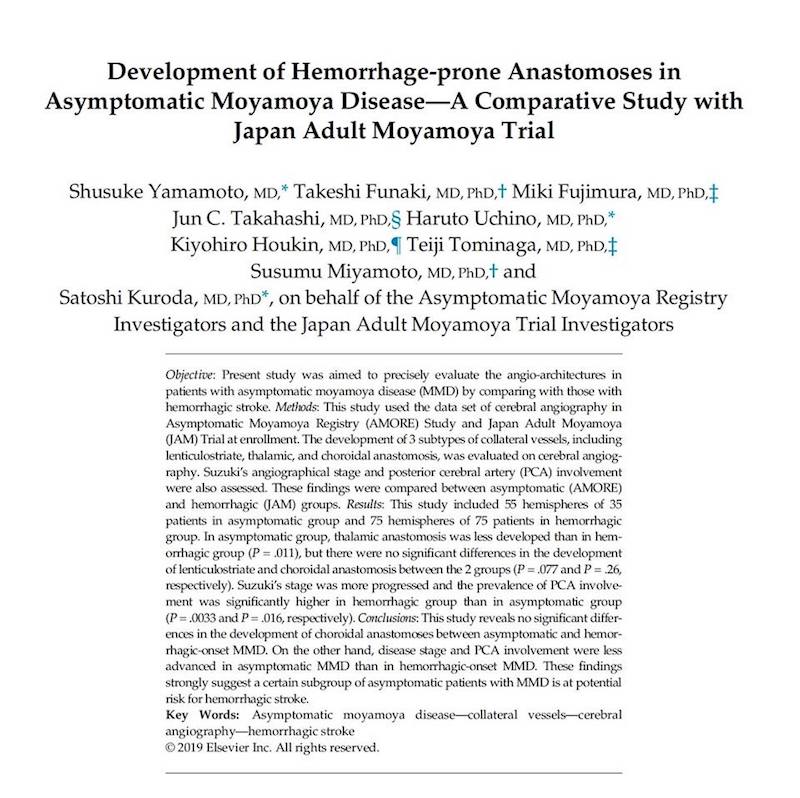
当科の山本修輔先生の研究成果がJournal of Stroke and Cerebrovascular Disease誌に掲載されました。
出血発症成人もやもや病(JAM研究)と無症候性もやもや病(AMORE研究)のもやもや血管を比較検討したところ、頭蓋内出血を来たしやすい脈絡叢動脈由来のもやもや血管の発達度に差がなかったという結果が得られました。今回の結果は、無症候性もやもや病の患者さんの中には、将来、頭蓋内出血をきたすリスクが高い患者さんが存在していることを強く示唆するデータです。
この研究は、厚生労働省・難病研究班のメンバー(富山大学、京都大学、東北大学、北海道大学)を中心にJAM/AMORE研究に参加している施設による共同研究です。
A Voyage to Depth of Neuroscience Vol. 62
Dr. Shusuke Yamamoto, one of our staffs, published his research data on cerebral angiography between asymptomatic moyamoya disease and hemorrhage-onset moyamoya disease in Journal of Stroke and Cerebrovascular Disease.
Yamamoto S, Funaki T, Fujimura M, Takahashi JC, Uchino H, Houkin K, Tominaga T, Miyamoto S, Kuroda S; Asymptomatic Moyamoya Registry Investigators and the Japan Adult Moyamoya Trial Investigators.
J Stroke Cerebrovasc Dis. 2019 Aug 27[Epub ahead of print]
Development of Hemorrhage-prone Anastomoses in Asymptomatic Moyamoya Disease-A Comparative Study with Japan Adult Moyamoya Trial.
OBJECTIVE:
Present study was aimed to precisely evaluate the angio-architectures in patients with asymptomatic moyamoya disease (MMD) by comparing with those with hemorrhagic stroke.
METHODS:
This study used the data set of cerebral angiography in Asymptomatic Moyamoya Registry (AMORE) Study and Japan Adult Moyamoya (JAM) Trial at enrollment. The development of 3 subtypes of collateral vessels, including lenticulostriate, thalamic, and choroidal anastomosis, was evaluated on cerebral angiography. Suzuki’s angiographical stage and posterior cerebral artery (PCA) involvement were also assessed. These findings were compared between asymptomatic (AMORE) and hemorrhagic (JAM) groups.
RESULTS:
This study included 55 hemispheres of 35 patients in asymptomatic group and 75 hemispheres of 75 patients in hemorrhagic group. In asymptomatic group, thalamic anastomosis was less developed than in hemorrhagic group (P = .011), but there were no significant differences in the development of lenticulostriate and choroidal anastomosis between the 2 groups (P = .077 and P = .26, respectively). Suzuki’s stage was more progressed and the prevalence of PCA involvement was significantly higher in hemorrhagic group than in asymptomatic group (P = .0033 and P = .016, respectively).
CONCLUSIONS:
This study reveals no significant differences in the development of choroidal anastomoses between asymptomatic and hemorrhagic-onset MMD. On the other hand, disease stage and PCA involvement were less advanced in asymptomatic MMD than in hemorrhagic-onset MMD. These findings strongly suggest a certain subgroup of asymptomatic patients with MMD is at potential risk for hemorrhagic stroke.









